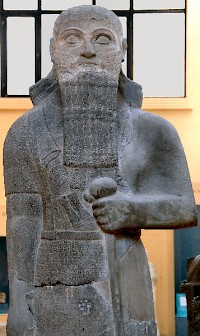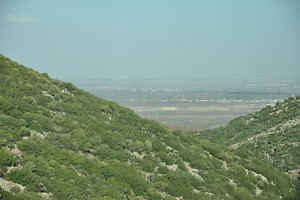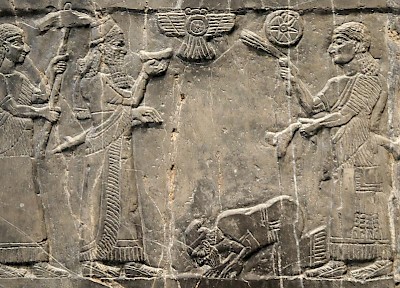Qarqar (853 BCE)
Q849474Battle of Qarqar: one of the fights during the Assyrian king Šalmaneser III's campaign against the city states of Syria. The main source is the Kurkh Stela, which has become famous because it mentions king Ahab of Israel.
Prelude

The Assyrian king Šalmaneser III was a remarkable warrior, who often fought against the city states in the west. In 857, he reached the Amanus Mountains and the Mediterranean shores, and in the next year, he settled Assyrians in this land. Far from stabilizing the region, it led to an escalation. The remaining city states and kingdoms in the west united in a defensive alliance, and seem to have tried to create dissension within the Assyrian realms. We are not certain about this, but the Kurkh Stela, our main source for Šalmaneser's western campaigns, refers to a rebel named Giammu in the valley of the river Balik. However this may be, Šalmaneser sought a decisive battle to show who was the boss.
He departed from Nineveh after the full month of the month Ajaru had been observed, as was customary, in the year in which Dayan-Aššur was limmu; comparison to the Assyrian Eponym List helps to establish that this was the spring of 853. The army marched to the west and encountered the first resistance in the valley of the river Balik, where Giammu had seized power. At Karchemish, which was by now called Kar-Šalmaneser, the Assyrian army crossed the Euphrates. At Pitru, the king received envoys from Melidu (Melitene), Gurgum, Kummuhi (Commagene), Karchemiš, and Arpad, who stressed their loyalty. More importantly, there were also representatives of the recently conquered territories in the west, Sam'al and Pattina.
Proceeding to the west, the Assyrian army reached Halman, or Aleppo, as we know it. The town belonged to Sam'al, which had already surrendered, but Šalmaneser presents its surrender as something special. He climbed to the citadel, sacrificed to Hadad, and proceeded to the southwest, where he invaded Hamath: the first kingdom of the anti-Assyrian coalition. Pillaging the land, the Assyrians tried to force their enemies to battle.
I approached the cities of [king] Irhuleni, the Hamathite. I captured Adennu, Parga, and Argana, his royal cities. I carried off captives, his valuables, and his palace possessions. I set fire to his palaces.
The army continued to the Qarqar, a town on the plain of the Orontes. If Hamath had been the aim of Šalmaneser's invasion, this is illogical, and we may assume that the king had another reason to go in this direction: because he knew that the army of his enemies was - or would be arriving - here. This makes sense. One of the newly conquered territories, Pattina, was on the lower Orontes, and it would be logical for the coalition to try to liberate this state: after all, the inhabitants had fresh memories of Assyrian conquest, and might easily support the allies. If this was indeed the operational aim of the coalition, it is logical to find them in the valley of the Orontes.
The coalition
In the Kurkh stela, Šalmaneser enumerates his opponents:
I razed, destroyed, and burned the city of Qarqar, the royal city.
- 1,200 chariots, 1,200 cavalry, and 20,000 troops of Hadad-Ezer ("Arad-idri") of Damascus;
- 700 chariots, 700 cavalry, and 10,000 troops of Irhuleni, the Hamathite;
- 2,000 chariots and 10,000 troops of Ahab, the Israelite;
- 500 troops of Byblos;
- 1,000 troops of Sumur;
- 10 chariots and 10,000 troops of the land of Irqanatu;
- 200 troops of Matinu-Ba'al of the city of Arvad;
- 200 troops of the land of Usanat;
- 30 chariots of Adon-Ba'al of the land of Šianu;
- 1,000 dromedaries of Gindibu of Arabia;
- ... hundred troops of Ba'asa of Bit-Ruhubi, the Ammonite;
These twelve kings he took as allies. They marched against me to do war and battle.
These lines are not unproblematic, if only because only eleven divisions are named. A possible solution is to assume that the final item is in fact a reference to two states: Ba'asa may have been king of Ammon and Beth-Rehob, although these two territories were separated by Damascus. Another solution is to assume that Qarqar, which had already been destroyed and could no longer fight, was the twelfth member of the league. However, it probably was not an independent state (the Antakya Stela proves that Hamath controlled large parts of the Orontes valley). The most likely solution is that the number twelve is just symbolic.
Battle

Šalmaneser describes the fight in highly stereotypical phrases:
With the supreme forces which Aššur, my lord, had given me and with the mighty weapons which the divine standard, which goes before me, had granted me, I fought with them. I decisively defeated them from the city of Qarqar to the city of Gilzau. I felt with the sword 14,000 troops, their fighting men. Like Adad, I rained down upon them a devastating flood. I spread out their corpses and I filled the plain. I felled with the sword their extensive troops. I made their blood flow in the wadis. The field was too small for laying flat their bodies; the broad countryside had been consumed in burying them. I blocked the Orontes river with their corpses as with a causeway. In the midst of the battle I took away from them chariots, cavalry, and teams of horses.
At this point, the account on the Kurkh Stela breaks off. This, and the great number of spelling errors, suggest that the stela had to be erected quickly. It had to be made clear to anyone who might have thought otherwise, that the king had achieved a splendid victory.
Aftermath
Reality may have been different. It seems that the battle of Qarqar had not been decisive, because we read about continuous warfare. Ten years later, Šalmaneser for the third time ordered the composition of his Annals ("Recension C"). The story of the campaign of 853 is summarized - the number of killed enemies is now 25,000 men - and we learn that the king boarded ships and went out upon the sea. But we also read that in 849, Šalmaneser had to fight against Karchemiš and Arpad, which had been loyal in 853, and against the coalition. Next year, the Assyrians again had to fight against Karchemiš, Arpad, and Hamath; a third battle against the coalition forces ended in the inevitable Assyrian victory. Whatever the nature of Assyria's victories, the fact that he king needed to return proves that Qarqar, whoever may have been the tactical victor, had been a strategic victory for the coalition, which was able to expand its power to Karchemiš and Arpad.

Recension C ends with another battle, in 845. This time, the coalition received no support from Arpad and Karchemiš, and it seems that this time, victory was decisive: the two states never returned to the coalition. "Recension D" of Šalmaneser's Annals, which is inscribed on two monumental bulls found in Kalhu (Nimrud), refers to another campaign, in 841. This time, the Assyrians seem to have met an isolated king Hazael of Damascus, because the coalition is not mentioned. They defeated him in battle, marched to Damascus, pillaged the land, and received tribute from Sidon, Tyre, and Israel. This was repeated three years later, although this time, the tribute bearers were Sidon, Tyre, and Byblos. The coalition had been broken, and Assyrian power in Syria was to last for two centuries.
Qarqar had not been decisive, but in retrospect, it had been the beginning of the end for independent Syria. In 833, Šalmaneser ordered his statue to be erected near one of the gates of Aššur. The inscription records operations in all parts of the known world, but from the western front, it mentions two campaigns only: Qarqar and the first attack on Damascus.